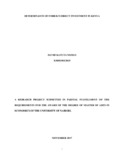| dc.description.abstract | FDI contributes enormously to the receiving nation through introduction of new technology, addressing the problem of savings deficiency, foreign exchange inadequacy, revenue gap, and issues relating to management etc. Due to these benefits, it is essential to understand the factors that affect the flow of FDI to be able to formulate and implement appropriate foreign investment policies. This study sought to investigate the role of real interest rate, trade openness, real effective exchange rate, rural population, urbanization and economic performance of neighbouring countries in EAC. The second objective of the study was to find out the nature of relationship that exists between the independent variables and FDI .Further, this study set out to shed light on the contested role of GDP, inflation and real exchange rate after different results were previously arrived at with Abala (2014) concluding that they significantly influenced FDI flow before Kwoba et.al (2016) finding them to be insignificant.
Using Cointegration test dependent and independent variables were found to have a long-run relationship. The OLS results found that economic performance of the neighbouring countries, real interest rates and urbanization were found to positively influence the flow of FDI to Kenya though they were insignificant. Urbanization and economic performance of neighbouring nations positively influenced the flow of FDI while rural population had a negative effect on the flow of FDI. Moreover, GDP was found to negatively and significantly affecting the flow of FDI to Kenya contrasting previous studies by Abala (2014) who found that GDP positively and significantly affected the flow of FDI to Kenya while Kwoba et.al (2016) had found out that it was positive but not significant.
The research utilized secondary time series data from Kenya National Bureau of Statistics (KNBS), World Development Indicators (WDI) and Statistical abstracts for the time period 1980.
In conclusion, the study recommended that government should take actions in urbanizing small towns to cities, ensuring it remains in the trading blocs with other trading partners in the region and ensuring trade openness and measures to increase returns on capital investment to increase flow of FDI to Kenya. | en_US |



